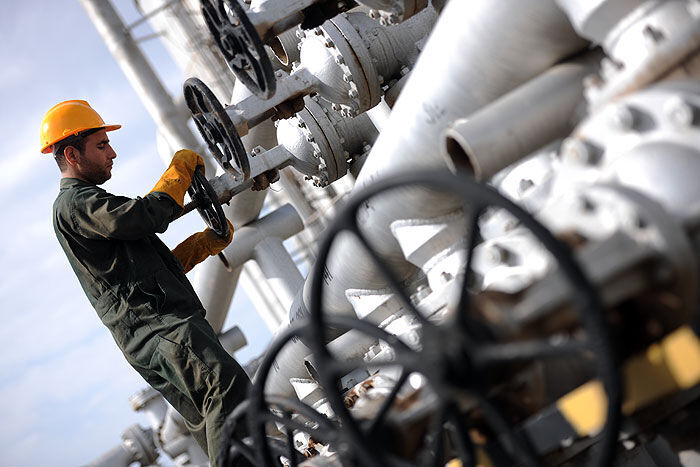Oil output up 1 mb/d
Tough sanctions against Iran’s petroleum industry and subsequently the decline in supply over recent years had forced NISOC to cut its production. However, although sanctions were still in effect from the very beginning, the 13th administration was determined to maximize oil production and sales. Two years on, Iran’s oil production had jumped as data show.
NISOC runs 45 hydrocarbon fields and 65 hydrocarbon reservoirs sprawling on 70,000 square kilometers extending from Bushehr to Khuzestan provinces. It supplies 75% of crude oil and 16% of gas output in the country. Ahvaz, Gachsaran, Maroun, Aghajari, Karanj, Parsi and Bibi Hakimeh are among major fields administered by NISOC.
Daneshi said arrangements had been made for NIOC’s oil output to grow, including overhaul of processing equipment, gas compressor stations, gas injection facilities, gas and LPG plants, slug catchers and manifolds. For the first time in the history of NISOC, 110 turbines and rotary machinery were domestically repaired through outsourcing.
That help increase NISOC’s oil output back to pre-sanctions levels. Now all NIOC wells are ready for production.
“Capacity building is under way to reach 3 mb/d. However, what we can easily achieve now is 2.8 mb/d output, which is possible in 45 days,” said Daneshi.
Not easy job
Restoring oil production capacity is not as easy as thought. Oil production could not increase as soon as one wishes it. Following tough sanctions imposed on Iran, National Iranian Oil Company (NIOC) directors decided to cut output. But when in parallel with this policy, no arrangement is thought for bringing oil output back to pre-sanctions levels, oil wells would be harmed, much less production companies would not be able to reach production targets due to the lack of capacity-building.
Daneshi said: “One of the battlefields against sanctions is Iran’s petroleum industry. Had we not redoubled our efforts during this time we would not have witnessed oil output hike as it has happened now.”
“I would also like to note that Iran’s petroleum industry is interlinked with all economic arteries of Iran and naturally we would never stop working,” he said.
Daneshi said plans had been envisaged for workover wells in order to preserve oil production, adding: “We were legally barred from drilling development wells, but we could work over our wells. However, due to sanctions, foreign companies denied us required equipment. Workover was not easy, but we exhausted our contracting capacity and NIOC’s potential.”
3.27 mb/d eyed
According to a five-year plan submitted to the Ministry of Petroleum, NISOC intends to bring its production from the current 2.943 mb/d to 3.279 mb/d by 2027.
“Reaching that level would require constant access to rigs and commodities, renovation of installations and pipelines and streamlining bureaucracy,” said Daneshi.
Minister of Petroleum Javad Owji has welcomed foreign investment in the upstream and downstream oil sector, saying: “We plan to attract $250 billion in investment into the petroleum industry over eight years.” He said that the 13th administration had struck $40 billion worth of agreements with local and foreign companies over the past 20 months.
When asked if foreign companies would be involved in NISOC’s output hike plans, Daneshi said: “Our current production capacity is a level which is achievable independently, but we will definitely welcome foreign engagement and investment where needed. We have already held talks with some foreign companies.”
He said that NISOC was in talks with Russian and Chinese companies to develop two oil reservoirs, adding that good talks were under way with other foreign investors, too.
Regarding the subject of talks with foreign companies, he said: “As Petroleum Ministry officials have said we need investment as we have extremely high potential in the petroleum industry. We believe that we need to have ties with foreign companies. Knowledge is always fluid. We are looking for bilateral relations. We are still lagging behind in exporting technical services. We should be more serious with regard to developing oil reservoirs, installations, training exports and selling petroleum commodities.”
Gas gathering
A significant initiative by the Ministry of Petroleum over the past two years has been the conclusion of associated petroleum gas gathering. NISOC has long had extensive plans to gather flare gas. Today, nearly 80% of flare gas is being gathered. Daneshi said: “Under the aegis of collaboration between NISOC and Persian Gulf Petrochemical Industries Company (PGPIC), more than 600 mcf/d of gas is gathered. We received the project while it had 10% physical progress, but we brought it to 45% by last March.”
Part of this project came online under the 13th administration, including NGL 1000 precompression, NGL 900 precompression, and Issar 400KV power supply station. Furthermore, a significant number of projects associated with the Persian Gulf Bidboland facility would come online by the end of the current calendar year ending on 20 March 2024.
Another gas gathering project pertains to the Maroun petrochemical plant, which is currently under way. Apart from that, 61 mcf of gas was auctioned off in northern Khuzestan, which was the first of kind in 43 years.
Iran holds over 33 tcm of natural gas, as well as 154 billion barrels of recoverable crude oil reserves, which puts it in first place in terms of combined oil and gas reserves in the world.
Iran recently managed to reach 3.8 mb/d of crude oil and gas condensate output and more than 1 bcm/d of rich gas, using 10 oil and 21 gas refineries. Given the country’s big oil and gas production capacity and global demand for energy security, the Ministry of Petroleum has formulated plans for output hike. Given the high rate of return on investment in the petroleum industry, Iran has sweetened the terms and conditions of contracts with a view to attracting foreign investment.
Iran Petroleum


Your Comment